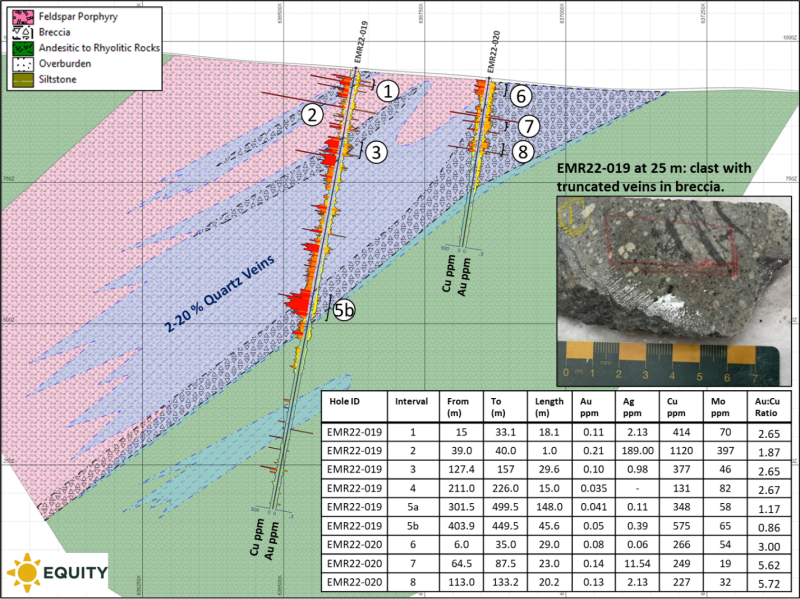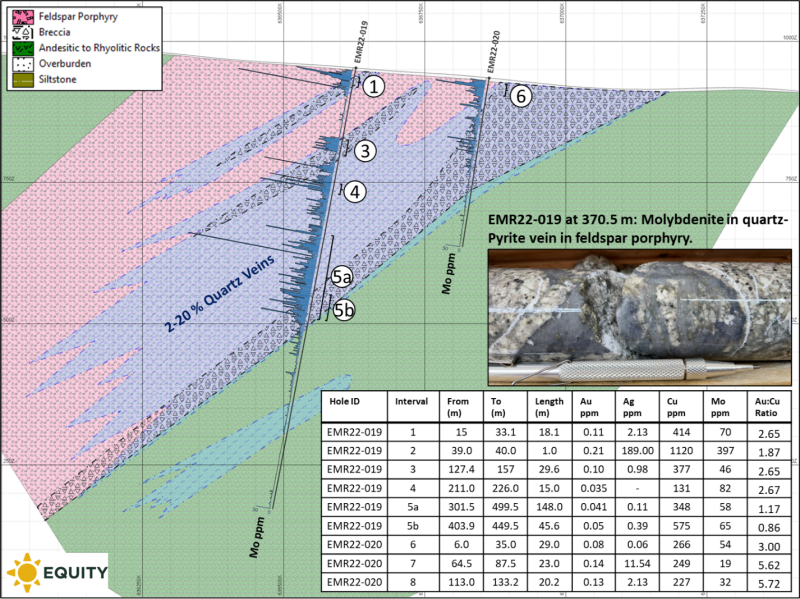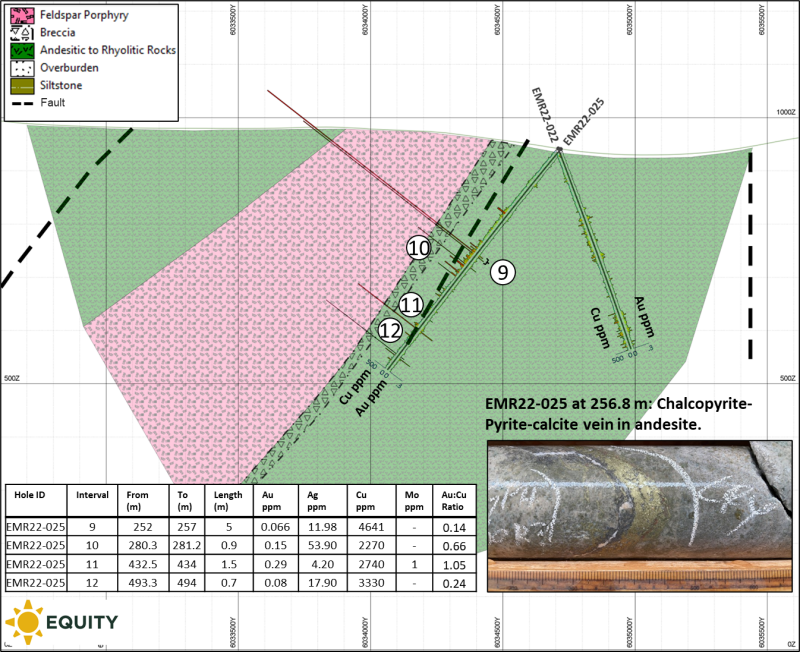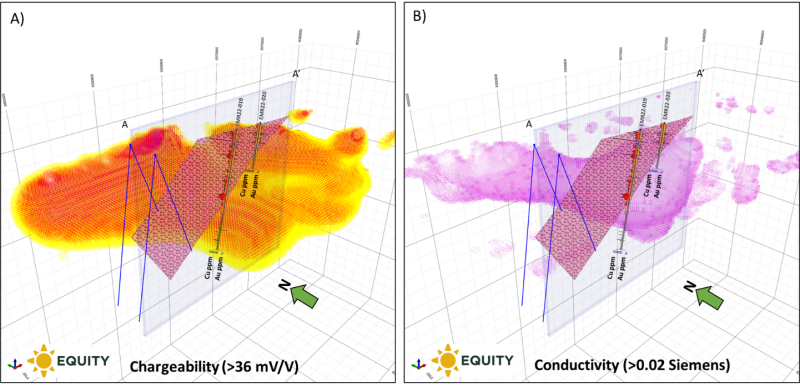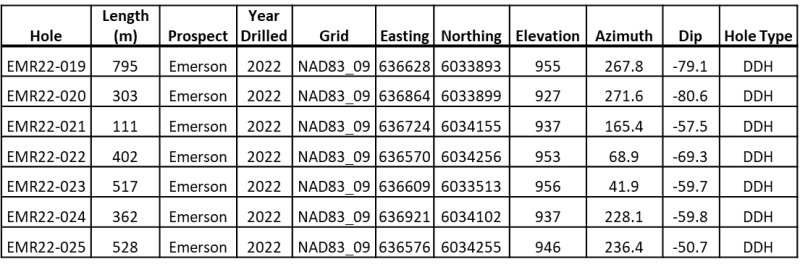Archive
HARVEST GOLD Initial Drill Program at Emerson Discovers a Copper Gold Mineralized Porphyry System
 | |||||||||
Vancouver, British Columbia / TheNewswire / June 06, 2022 ‑ Harvest Gold Corporation (TSXV:HVG) (“Harvest Gold” or the “Company”) is pleased to provide an update on its recently completed initial drill program at its 100% owned Au-Cu Emerson property. The 56 km2 Emerson property is in central B.C., 15 km west of Houston B.C. and comprises 14 contiguous mineral claims. An active railroad, high voltage powerline and gas pipeline are located within or proximal to the property with convenient access by a series of forest service roads.
The Company’s geological consultants, Equity Exploration Consultants Ltd. (“Equity”) have reviewed and modelled results from 2,432 samples collected from 3,017 m of core drilled in seven holes during its initial spring 2022 drill program at Emerson.
Harvest Gold President and CEO, Rick Mark states, “From the outset we believed Emerson had the potential to host (1) Au-Ag mineralization analogous to the Blackwater deposit; and (2) a large porphyry Cu-Au±Mo system analogous to the New Prosperity deposit. This first drill program did not discover evidence of the Au-Ag Blackwater-like system but has uncovered strong evidence for a large porphyry Cu-Au±Mo system. In today’s release we report on results of this drill program and present a plan to follow up on the porphyry target. I would like to thank our entire Harvest Gold team and the outstanding Geologists at Equity for their coordinated efforts and excellent on budget work”.
Henry Awmack, a member of Harvest Gold’s Technical Advisory Board and property co-vendor states, “It appears that the initial diamond drilling cut the top of a porphyry system, with weakly elevated copper-gold-molybdenum values. Especially encouraging is the high Au:Cu ratios intersected within the porphyry body, which ranges from 0.86 to 5.72 (measured as the ratio of Au ppm to percent Cu). This raises expectations that a postulated down-dip mineral system may also be gold-rich.”
Highlights
-
Initial diamond drill testing at our Emerson Project uncovered strong evidence for a large porphyry copper-gold-molybdenum system. Diamond drilling found that the large, induced polarization (“IP”) anomaly at Emerson is associated with strong to intense quartz-sericite-pyrite-clay alteration in feldspar porphyries and hydrothermal breccias intruding Kasalka Group volcanic rocks. Anomalous copper, gold, and molybdenum is specifically hosted within the feldspar porphyry shown in Figures 2 and 3. This direct association provides support that this intrusion may be part of a larger metalliferous complex that Harvest Gold has just begun to uncover.
-
Drilling along section A-A’ shown in Figure 2 indicates that the intrusive system is tilted to the west. Cu-Au mineralization is coupled, indicating a geological relationship between the metals. The hydrothermal breccias intersected in holes EMR22-019 and EMR22-020 have elevated Cu and Au relative to coherent sections of the porphyry intrusion. The hydrothermal breccias contain clasts of truncated, mineralized quartz veins in a weakly mineralized matrix as shown in Figure 2. This geological relationship suggests that a stronger, better mineralized system at depth was sampled by these breccias.
-
The feldspar porphyry drilled in holes EMR22-019 and EMR22-020 hosts intense quartz stockwork zones with 2 - 20 % quartz veining. This quartz stockwork zone is associated with anomalous Mo as shown in Figure 3. The Cu-Au bearing hydrothermal breccias appear to intrude into this quartz stockwork zone suggesting that the Cu-Au mineralization may have intruded into an earlier Mo porphyry system or into the upper levels of a larger porphyry Cu-Au-Mo system at depth.
-
Drill hole EMR22-025 on section B-B’ to the northwest of A-A’ was drilled into volcanic rocks separated from the Cu-Au-Mo mineralized feldspar porphyry by a fault. Drilling intersected polymetallic veins that were moderate to highly anomalous in Cu±Ag±Au as shown in Figure 4. These veins are characteristic of polymetallic veins that occur in the “halo” of many porphyry systems.
Since beginning work at Emerson, Harvest Gold has continually built evidence for a large hydrothermal system. Drilling reported in this release provides further evidence of geologic features characteristic of strong porphyry systems. Specifically, the Emerson prospect is characterized by:
-
(1)a large quartz-sericite-pyrite±clay footprint that remains open to the northwest that is of a magnitude to host one or more porphyry centres;
-
(2)drilling intersected intense quartz stock-work style veining indicative of high fluid flow;
-
(3)Cu-Au mineralization intersected is coupled and has a high Au:Cu ratio; and
-
(4)multiple intrusive types were encountered.
In Figure 5, Harvest Gold presents its plan for additional drilling to test for the stronger mineral system indicated by this initial program. The proposed drilling will test the down-dip continuation of the porphyry system to the west of EMR22-019. Additional holes would be drilled to the north would also explore the northwest continuation of the mineral system. Additional 3D-DC Induced Polarization may be conducted to define the northern extents of the Emerson hydrothermal system.
The results of drilling reported here diminishes Emerson’s potential for hosting significant Au-Ag mineralization analogous to the Blackwater deposit. Gold values ranged from 0.005 ppm to 1.44 ppm within extensive intervals of clay-pyrite alteration encountered by drilling; but were generally below 0.10 ppm.
There were no other significant intersections other than the intervals presented in Figures 2, 3, and 4. Holes EMR22-021 and EMR22-024 were ended prematurely due to difficult drilling in faults. Hole EMR22-022 intersected a few minor intervals of feldspar porphyry intrusions. Hole EMR22-023 drilled into a weakly altered and weakly mineralized feldspar porphyry that did not have the same metal endowment as the intrusions drilled in EMR22-019 and EMR22-020.
Figure 1: Plan map of the Emerson prospect. Drill collars and traces in blue indicate drill holes presented in cross-sections below. Interpreted quartz-muscovite-pyrite-clay alteration, and chargeability anomaly are all open to the west-northwest. Sections A-A’ and B-B’ are presented in Figures 2, 3, and Figure 4, respectively.
Figure 2: East to West section A-A’ looking north through EMR22-019 and -020. Copper and gold assays shown along drill trace over interpreted geology. Inset photo shows a clast containing mineralized quartz veins within a breccia in interval 1. Au and Cu are seen to be coupled together within the feldspar porphyry with overall higher grades to the west. Au:Cu ratios within mineralized zones are generally above 1:1 and increases to ~2.5:1 in intervals 1 and 3 where truncated veins were seen. Readers should note that intervals are downhole core lengths. True widths are unknown.
Figure 3: East to West section A-A’ looking north through EMR22-019 and -020. Molybdenum assays shown to the left of the drill trace over interpreted geology. Inset photo shows molybdenite mineralization in a quartz-pyrite vein within interval 5a. Readers should note that intervals are downhole core lengths. True widths are unknown.
Figure 4: Northeast-Southwest section B-B’ looking northwest through EMR22-022 and-025. Copper and gold assays shown along drill trace over interpreted geology. Inset photo shows a chalcopyrite-pyrite vein within andesite in interval 9. Au:Cu ratios are generally < 1:1 here as this is interpreted to be within the “halo” distal to the porphyry centre. Readers should note that intervals are downhole core lengths. True widths are unknown.
Figure 5: Oblique view of proposed drill holes. Two drill pads are proposed to the west of section A-A’, with two additional holes collared 200 m to the north with intention of testing the mineral system to the northwest. Interpreted feldspar porphyry along section A-A’ is shown as a pink hatch. A) 3D IP chargeability anomaly B) 3D IP Conductivity anomaly.
Table 1: Drill hole locations, azimuth, and dip for the Spring 2022 work program at the Emerson prospect.
Quality Assurance and Quality Control Procedure
All sample assay results have been monitored through the Company's quality assurance / quality control (QA/QC) program. Drill core was sawn in half at Harvest Gold's core logging and processing facility in Houston, B.C. Half of the core was sampled and shipped in sealed and secure bags to the ALS Global preparation facilities in Smithers, B.C. Samples were prepared using standard preparation procedures. Following sample preparation, the pulps were sent to the ALS Global analytical laboratory in North Vancouver, B.C. for analysis.
Core samples were analyzed for 48 elements by ICP-MS on a 0.25 gram sample using a four acid digestion (method MEMS61L). Gold was analyzed by fire assay on a 30 gram sample with an AAS finish (method Au-AA23). Samples with >10 parts per million (ppm) gold were re-analyzed by fire assay using a gravimetric finish on a 30 gram sample. Samples with >100 ppm silver were re-analyzed using a four acid digestion and ICP-AES finish. Samples with >10,000 ppm zinc were re-analyzed using a four acid digestion and ICP-AES finish. ALS Global is registered to ISO / IEC 17025:2017 accreditations for laboratory procedures.
In addition to ALS Global laboratory QA/QC protocols, Equity implements an internal QA/QC program that includes the insertion of duplicates, standards and blanks into the sample stream.
Qualified Person Statement
The disclosure of technical or scientific information in this press release has been reviewed and approved by Warren Bates, P.Geo. Director of Property Investigation for Harvest Gold. Mr. Bates serves as a Qualified Person under the definition of National Instrument 43-101, Standards of Disclosure for Mineral Projects of the Canadian Securities Administrators.
About Harvest Gold Corporation
Harvest Gold is focused on the Interior Plateau of British Columbia exploring for near surface gold deposits and Copper Gold Porphyry deposits. Harvest Gold’s board of directors, management team and technical advisors have collective geological and financing experience exceeding 400 years.
Harvest Gold acknowledges that the Emerson and Goathorn Projects are situated in the traditional territory of the Wet’suet’en Nation while the Jacobite Project is situated in the traditional territory of the Lake Babine Nation. Harvest Gold is committed to developing positive and mutually beneficial relationships based on respect and transparency with local Indigenous communities.
ON BEHALF OF THE BOARD OF DIRECTORS
Rick Mark
President and CEO
Harvest Gold Corporation
For more information please contact:
Rick Mark or Jan Urata
@ 604.737.2303 or info@harvestgoldcorp.com
Neither TSX Venture Exchange nor its Regulation Services Provider (as that term is defined in the policies of the TSX Venture Exchange) accepts responsibility for the adequacy or accuracy of this release.
Forward Looking Information
This news release includes certain statements that may be deemed "forward looking statements". All statements in this news release, other than statements of historical facts, that address events or developments that Harvest Gold expects to occur, are forward looking statements. Forward looking statements are statements that are not historical facts and are generally, but not always, identified by the words "expects", "plans", "anticipates", "believes", "intends", "estimates", "projects", "potential" and similar expressions, or that events or conditions "will", "would", "may", "could" or "should" occur.
Although the Company believes the expectations expressed in such forward-looking statements are based on reasonable assumptions, such statements are not guarantees of future performance and actual results may differ materially from those in the forward-looking statements. Factors that could cause the actual results to differ materially from those in forward looking statements include market prices, exploitation and exploration successes, and continued availability of capital and financing, and general economic, market or business conditions. Investors are cautioned that any such statements are not guarantees of future performance and actual results or developments may differ materially from those projected in the forward-looking statements. Forward looking statements are based on the beliefs, estimates and opinions of the Company’s management on the date the statements are made. Except as required by securities laws, the Company undertakes no obligation to update these forward-looking statements in the event that management's beliefs, estimates or opinions, or other factors, should change.

